Accepted Scientific Name: Echinopsis leucantha (Gillies ex Salm-Dyck) Walp.
Repert. Bot. Syst. (Walpers) ii. 324. 1843 Walp.

Echinocactus leucanthus (Echinopsis leucantha) Photo by: Carolina González
Origin and Habitat: Western Argentina (Buenos Aires, Catamarca, Córdoba, La Pampa, La Rioja, Mendoza, Rio Negro, Salta, San Juan, San Luis, Santiago del Estero, Tucumán)
Type locality: Mendoza.
Altitude range: 0 to 2,300 metres above sea level.
Habitat and Ecology: This species is frequent in shrublands and forests, where it grows on sandy, silty and gravel soils. This cactus is common in some of the locations where it occurs, has no threats and is present within several protected areas.
Synonyms:
See all synonyms of Echinopsis leucantha
back
Accepted name in llifle Database:Echinopsis leucantha (Gillies ex Salm-Dyck) Walp.Repert. Bot. Syst. (Walpers) ii. 324. 1843Synonymy: 17
back
Common Names include:
ENGLISH: Queen of the Night, Easter Lily Cactus, Turkey-head cactus
Description: Stems: Globose to elongating grayish-green to brownish , about 15-35 cm high and 10-15 cm in diameter, becoming cylindric eventually up to 1,5 m tall, usually simple or offsetting from the about 10 cm in diameter.
Ribs: 10 to 14, straight, somewhat compressed.
Areoles: Close together, oblong.
Radial spines: 7-8, up to 2 cm long more or less curved, brownish.
Central spine: 1, pointing upwards, curved and sometime almost hooked, elongated, often 10 cm long dark brown.
Flowers: White or pale pink, trumpet shaped about 16 cm long; the tube about 3 cm broad at the mouth, dark brown, with scattered areoles bearing small tufts of brown hairs; outer perianth-segments brownish, spreading, 2 cm long, with an acute scarious tip; inner perianth-segments in about 3 series, spreading, the outer ones purplish, the innermost ones nearly white, oblong, acute, about 3 cm long; filaments in many series of many lengths with no separate throat circle, the series at the mouth of the flower-tube erect, 1,5 cm long; style included; stigma-lobes numerous, green.
Blooming season: Spring to summer.
Subspecies, varieties, forms and cultivars of plants belonging to the Echinopsis leucantha group
Bibliography: Major references and further lectures
1) Nathaniel Lord Britton, Joseph Nelson Rose “Cactaceae: Descriptions and Illustrations of Plants of the Cactus Family” Courier Dover Publications, 1963
2) James Cullen, Sabina G. Knees, H. Suzanne Cubey “The European Garden Flora Flowering Plants: A Manual for the Identification of Plants Cultivated in Europe, Both Out-of-Doors and Under Glass” Cambridge University Press, 11/Aug./2011
3) David Hunt, Nigel Taylor “The New Cactus Lexicon” DH Books, 2006 ISBN 0953813444, 9780953813445.
4) Edward F. Anderson “The Cactus Family” Timber Press, 2001
5) Clive Innes, Charles Glass “Cacti” Portland House, 01/May/1991
6) Méndez, E., Ortega-Baes, P. & Kiesling, R. 2013. Echinopsis leucantha. The IUCN Red List of Threatened Species. Version 2014.3. <www.iucnredlist.org>. Downloaded on 31 March 2015.
 Echinocactus leucanthus (Echinopsis leucantha) Photo by: Carolina González
Echinocactus leucanthus (Echinopsis leucantha) Photo by: Carolina González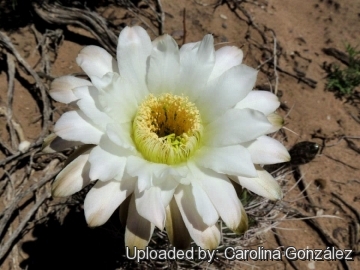 Flower in habitat. (Echinopsis leucantha) Photo by: Carolina González
Flower in habitat. (Echinopsis leucantha) Photo by: Carolina González Echinocactus leucanthus (Echinopsis leucantha) Photo by: Valentino Vallicelli
Echinocactus leucanthus (Echinopsis leucantha) Photo by: Valentino Vallicelli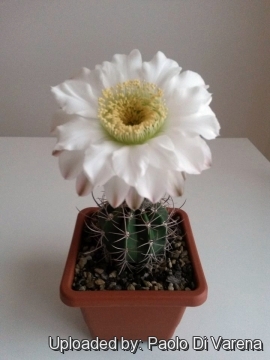 Echinocactus leucanthus (Echinopsis leucantha) Photo by: Paolo Di Varena
Echinocactus leucanthus (Echinopsis leucantha) Photo by: Paolo Di Varena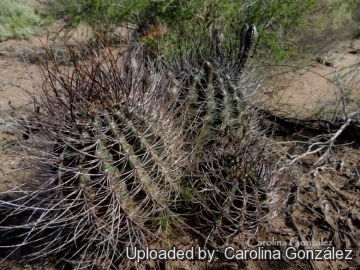 A large clump. (Echinopsis leucantha) Photo by: Carolina González
A large clump. (Echinopsis leucantha) Photo by: Carolina González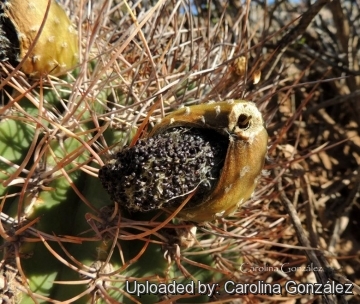 Mature fruit and seed. (Echinopsis leucantha) Photo by: Carolina González
Mature fruit and seed. (Echinopsis leucantha) Photo by: Carolina González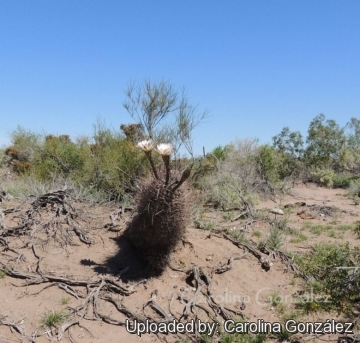 Echinocactus leucanthus (Echinopsis leucantha) Photo by: Carolina González
Echinocactus leucanthus (Echinopsis leucantha) Photo by: Carolina González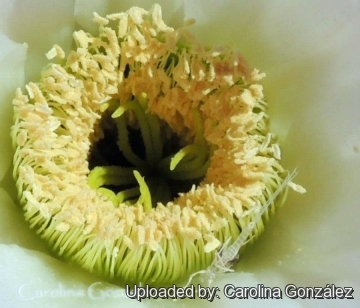 Flower (detail with the exoskeleton of an insect) in habitat. (Echinopsis leucantha) Photo by: Carolina González
Flower (detail with the exoskeleton of an insect) in habitat. (Echinopsis leucantha) Photo by: Carolina GonzálezCultivation and Propagation: This cactus is kept for the beauty of its form and spination. It is a summer grower species slow but easy to cultivate that, like many cacti of the Peruvian deserts, presents some problems in cultivation. It is in fact somewhat rot prone if kept in a non ventilated place.
Growth rate: It is a relatively rapidly growing and easily flowering species that will make clumps given the best conditions.
Soils: It likes very porous standard cactus mix soil, but can become too elongated if compost is too rich.
Repotting: Use pot with good drainage.
Watering: Water regularly from Spring to Autumn, but do not overwater and let the soil mix dry between waterings (Rot prone), keep dry in winter.
Fertilization: Feed with a high potassium fertilizer in summer.
Hardiness: Reputedly somewhat resistant to frost if kept on the dry side prior to, and during, cold weather (hardy to -12 C ° C, or less for short periods).
Exposition: Outside bright but filtered sunlight or afternoon shade, inside it needs bright light, and some direct sun. Tends to bronze in strong light, which encourages flowering and heavy spine production.
Uses: It is an excellent plant for container growing. It always looks good and stays small. It look fine in a cold greenhouse and frame or outdoor in a rockery.
Pests & diseases: It may be attractive to a variety of insects, but plants in good condition should be nearly pest-free, particularly if they are grown in a mineral potting-mix, with good exposure and ventilation. Nonetheless, there are several pests to watch for:
- Red spiders: Red spiders may be effectively rubbed up by watering the infested plants from above.
- Mealy bugs: Mealy bugs occasionally develop aerial into the new growth among the wool with disfiguring results, but the worst types develop underground on the roots and are invisible except by their effects.
- Scales: Scales are rarely a problem.
It is wise to treat your whole collection with a systemic insecticide twice a year in spring and autumn.
- Rot: Rot is only a minor problem with cacti if the plants are watered and “aired” correctly. If they are not, fungicides won't help all that much.
Propagation: Seeds (or offsets if available). Seeds germinate in 7-14 days at 21-27° C in spring, remove gradually the glass cover as soon the plants will be well rooted (ca 1-2 weeks) and keep ventilated, no full sun for young plants!
Your Photos

by Carolina González

by Carolina González

by Carolina González

by Carolina González

by Carolina González























